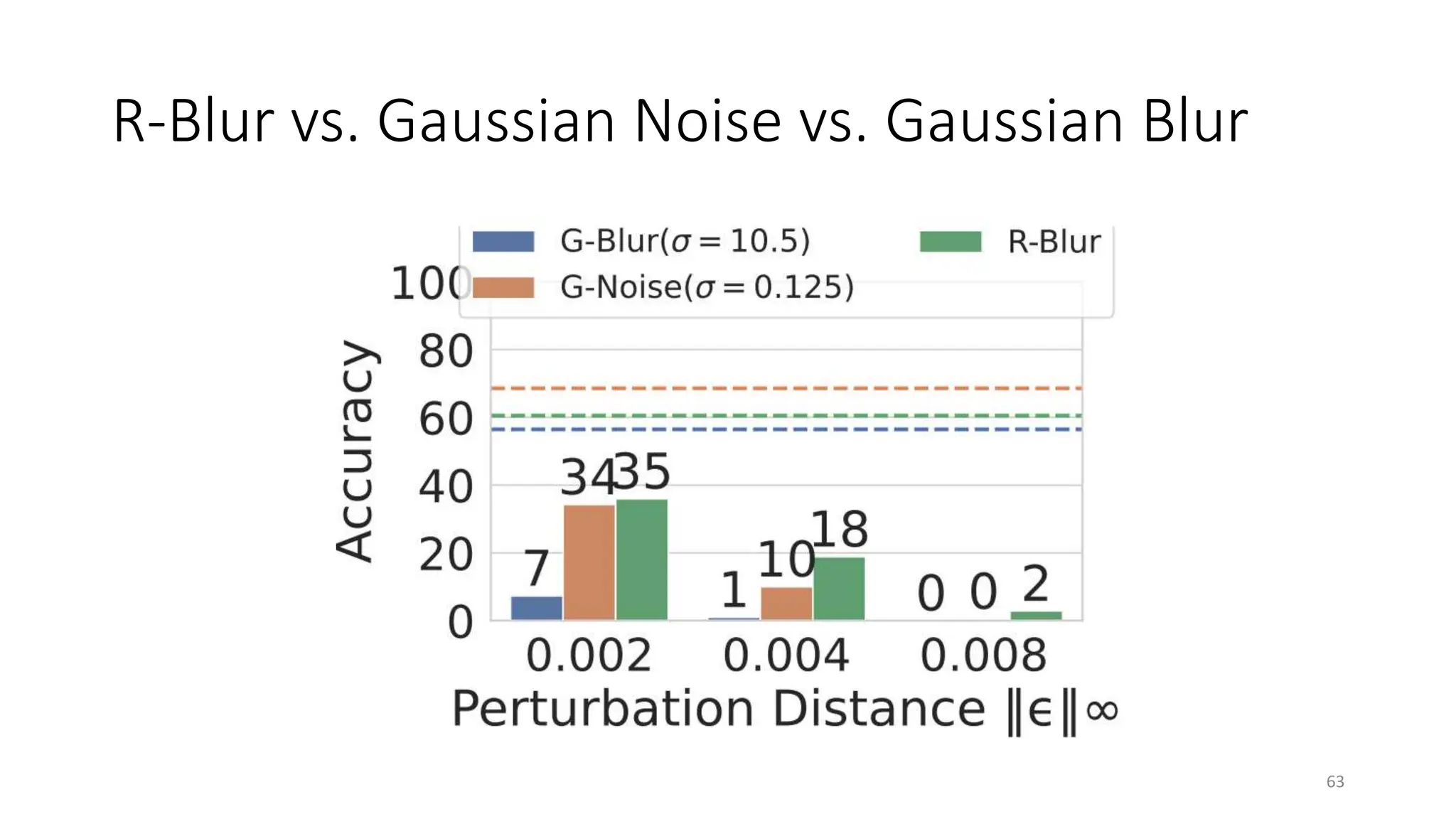The document discusses biologically inspired strategies for improving the adversarial robustness of deep neural networks (DNNs), specifically through methods like foveation via adaptive blurring and desaturation. It emphasizes the importance of aligning DNNs with human perception to mitigate vulnerabilities against adversarial attacks and presents various biological principles that can enhance robustness. Key findings indicate that techniques like r-blur and biologically plausible audio features can significantly improve DNN performance against both adversarial and non-adversarial perturbations.

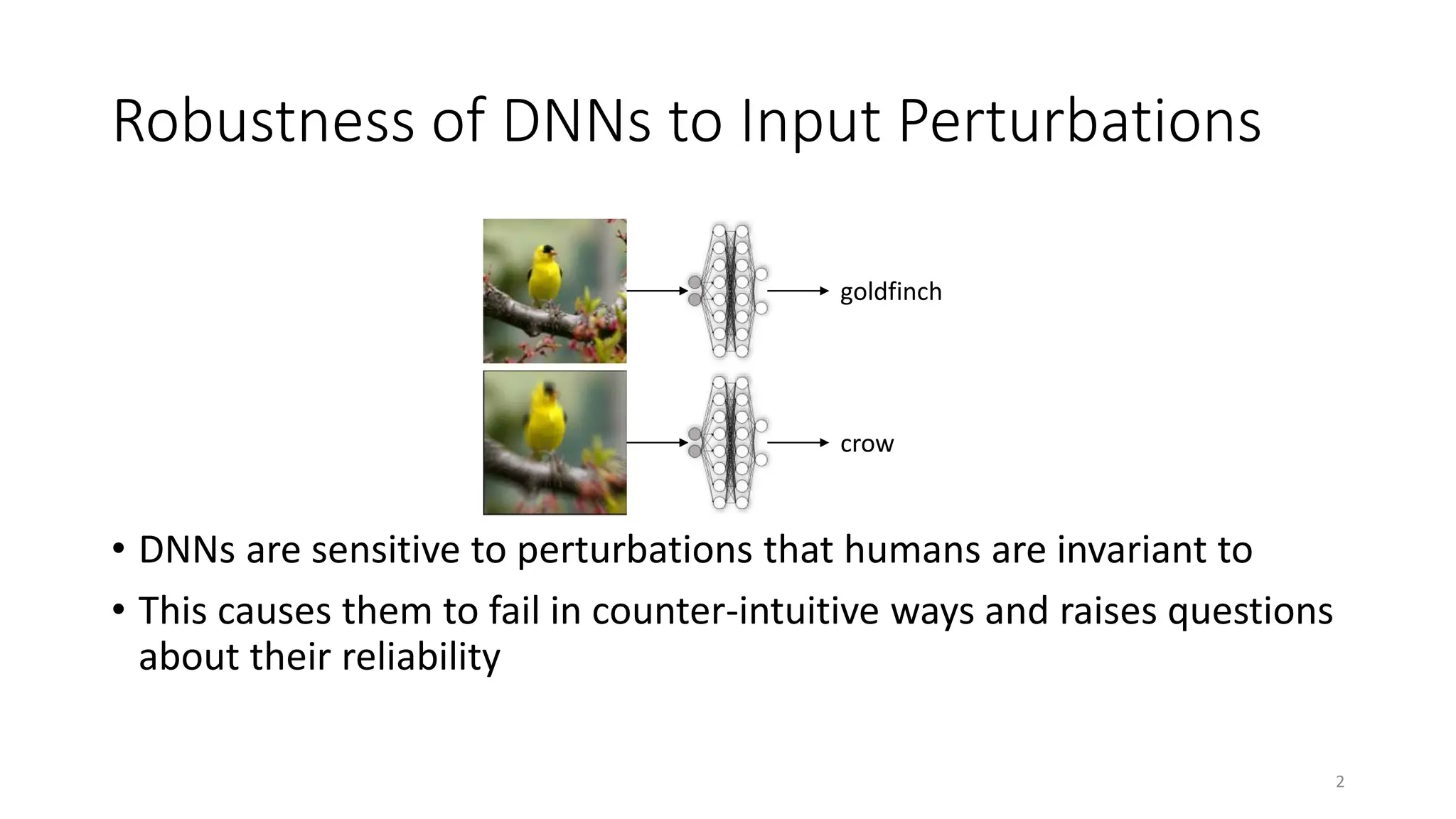
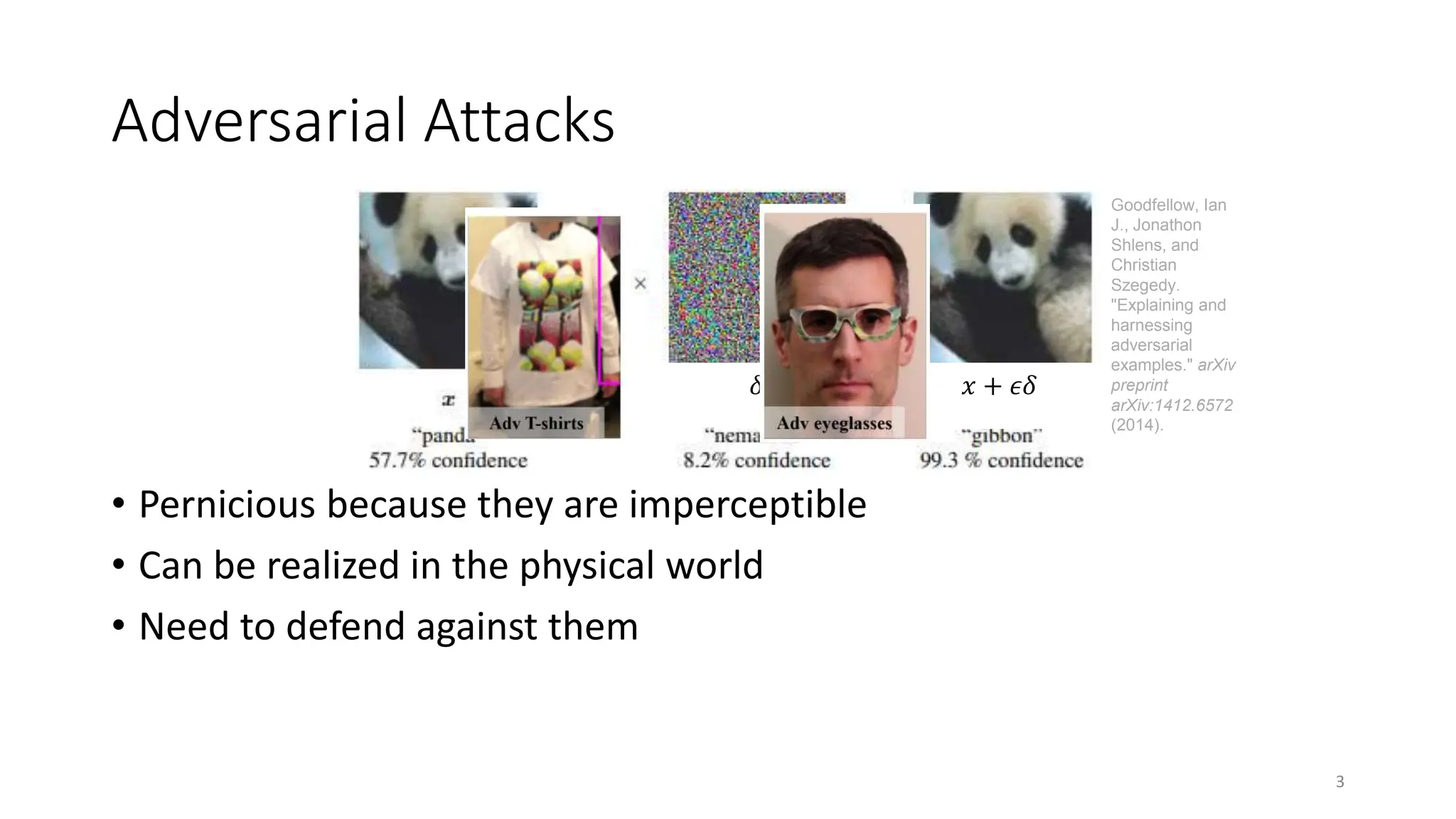

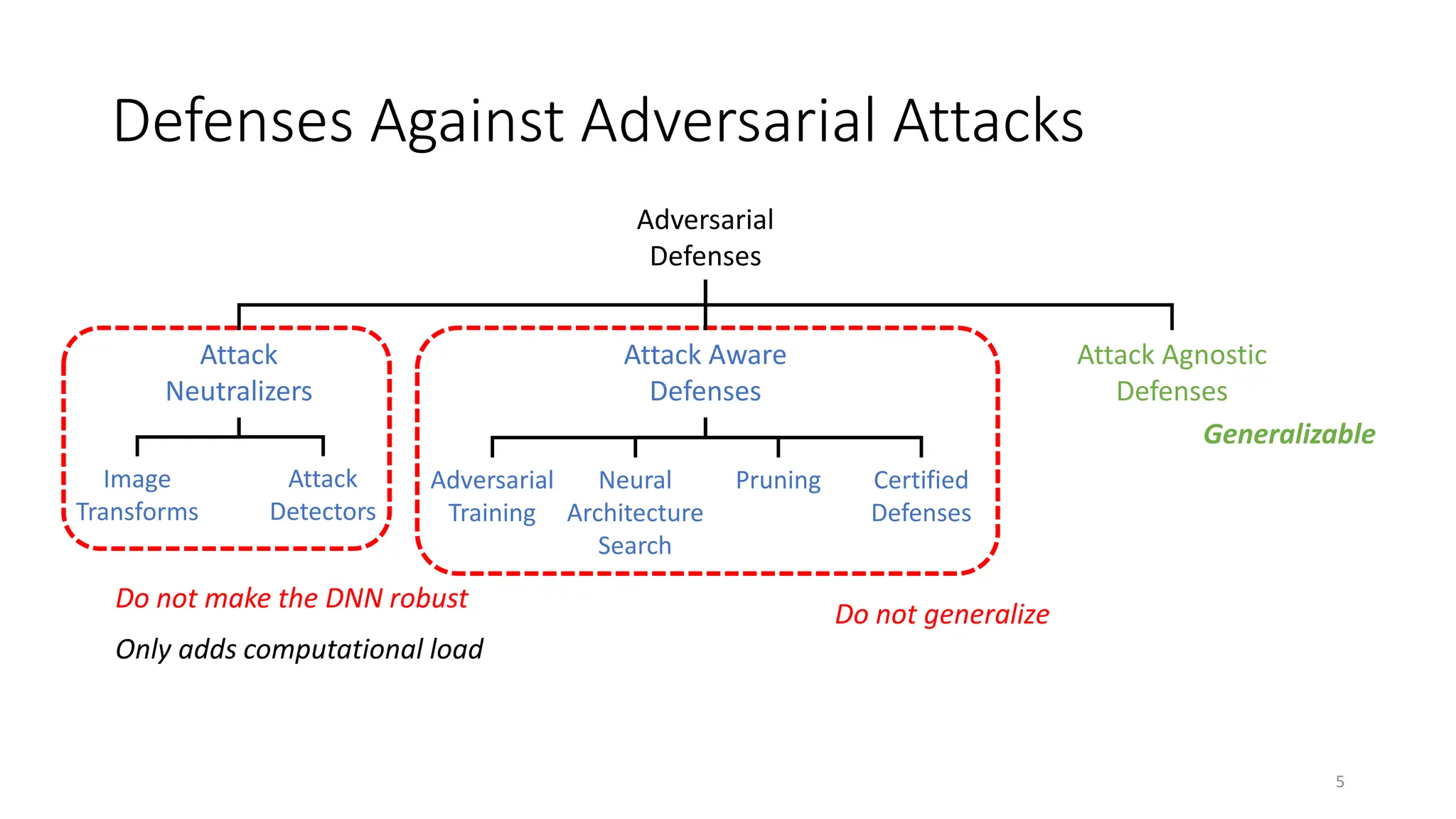
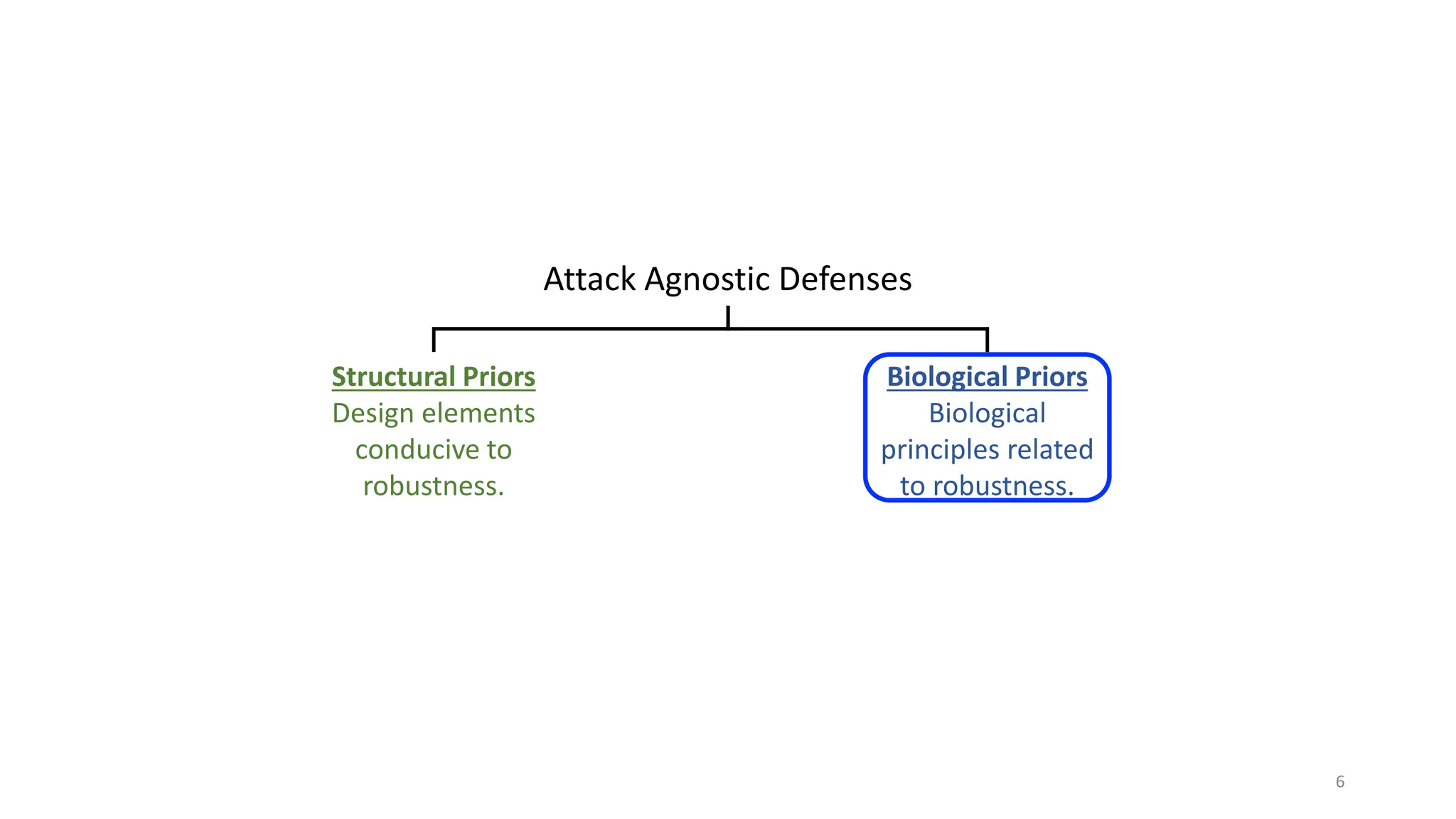
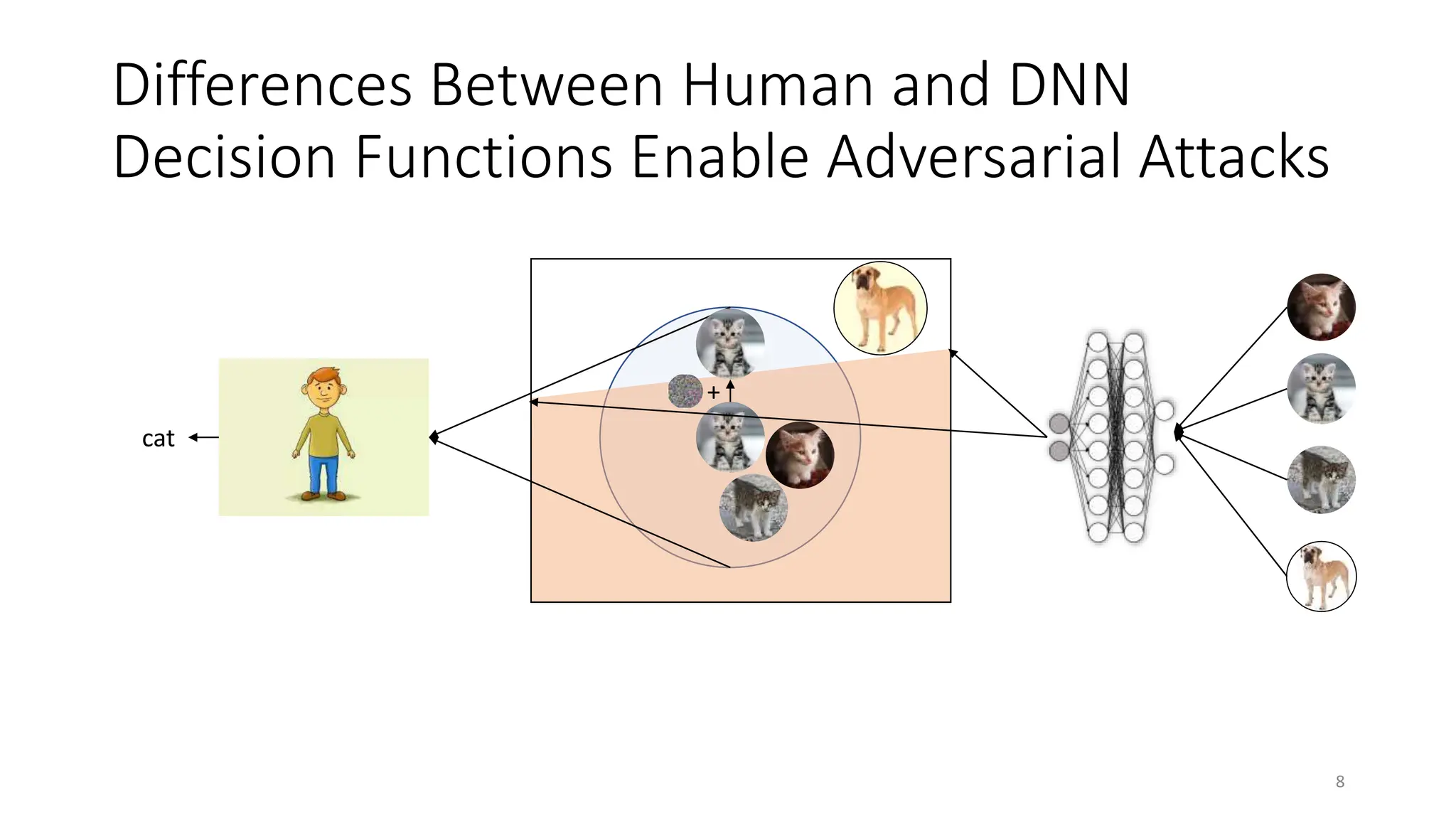

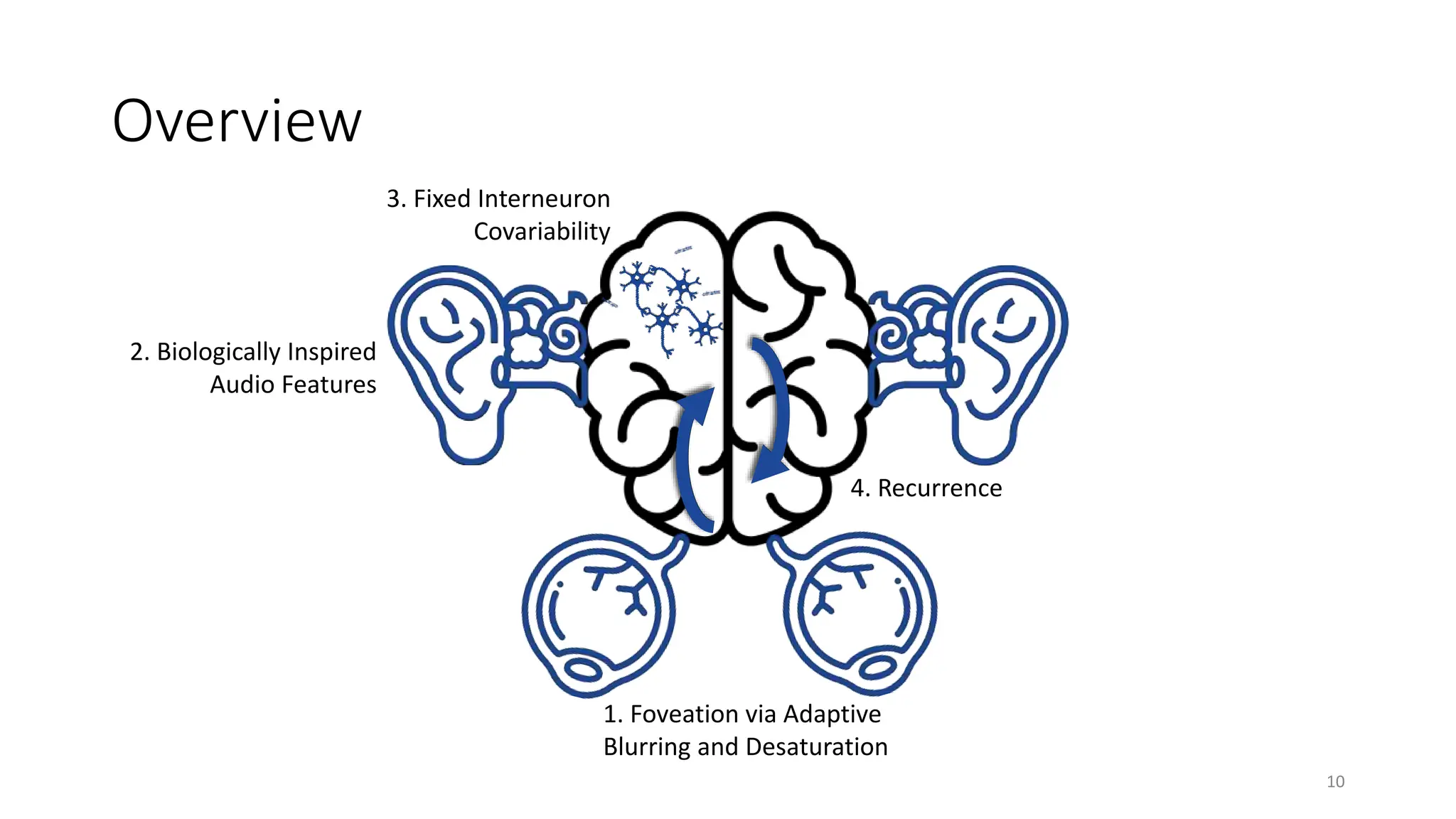



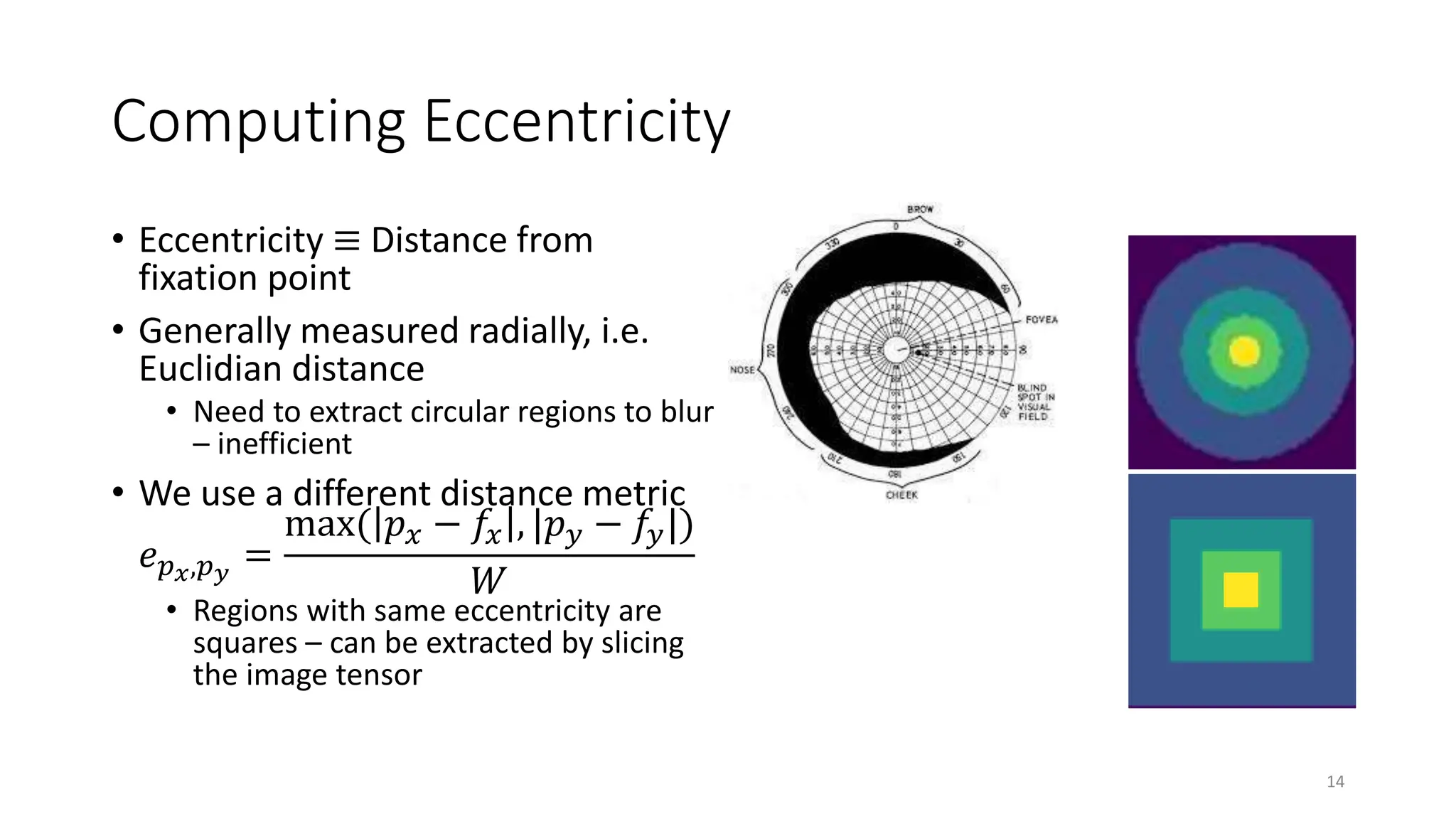





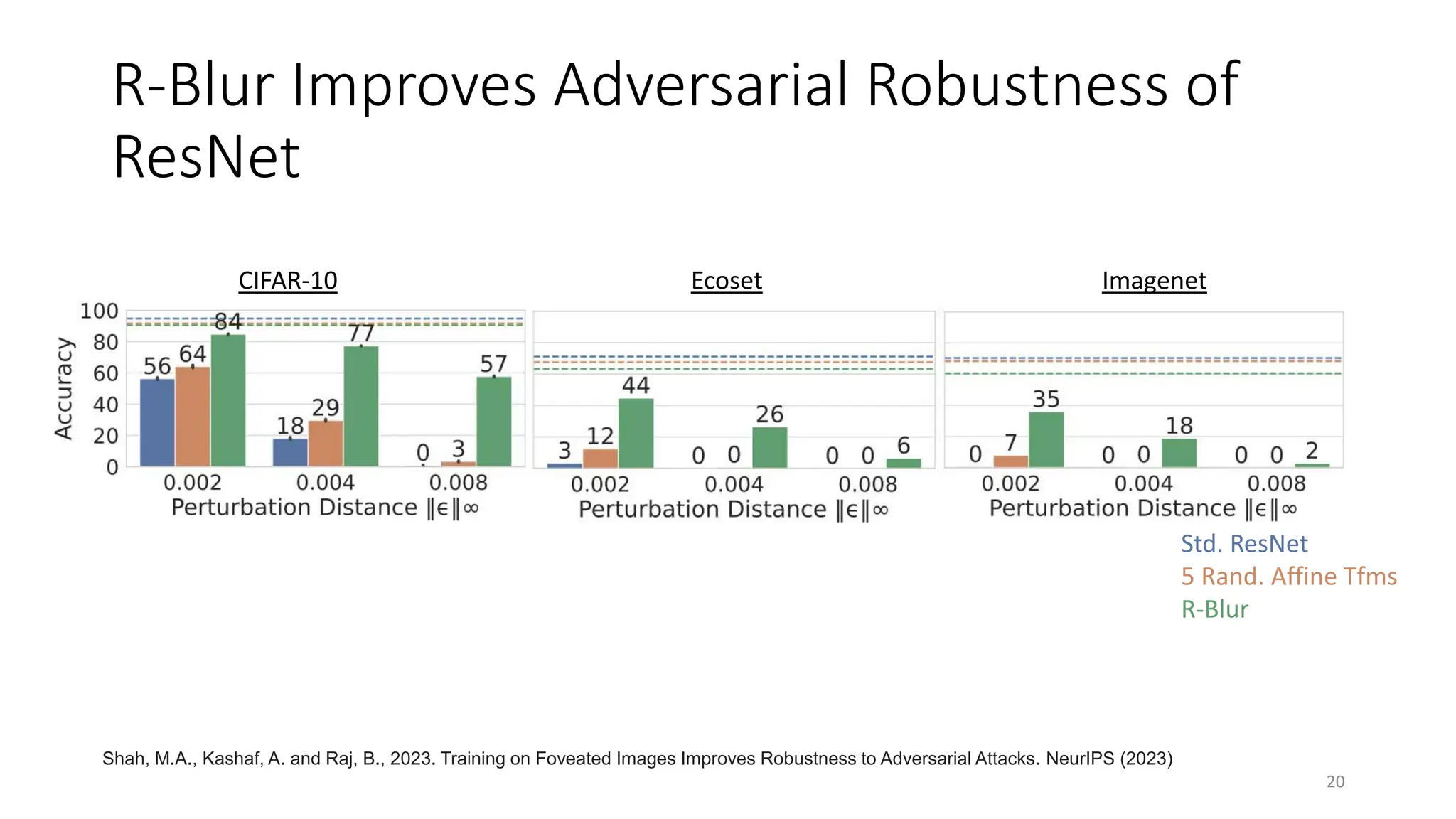






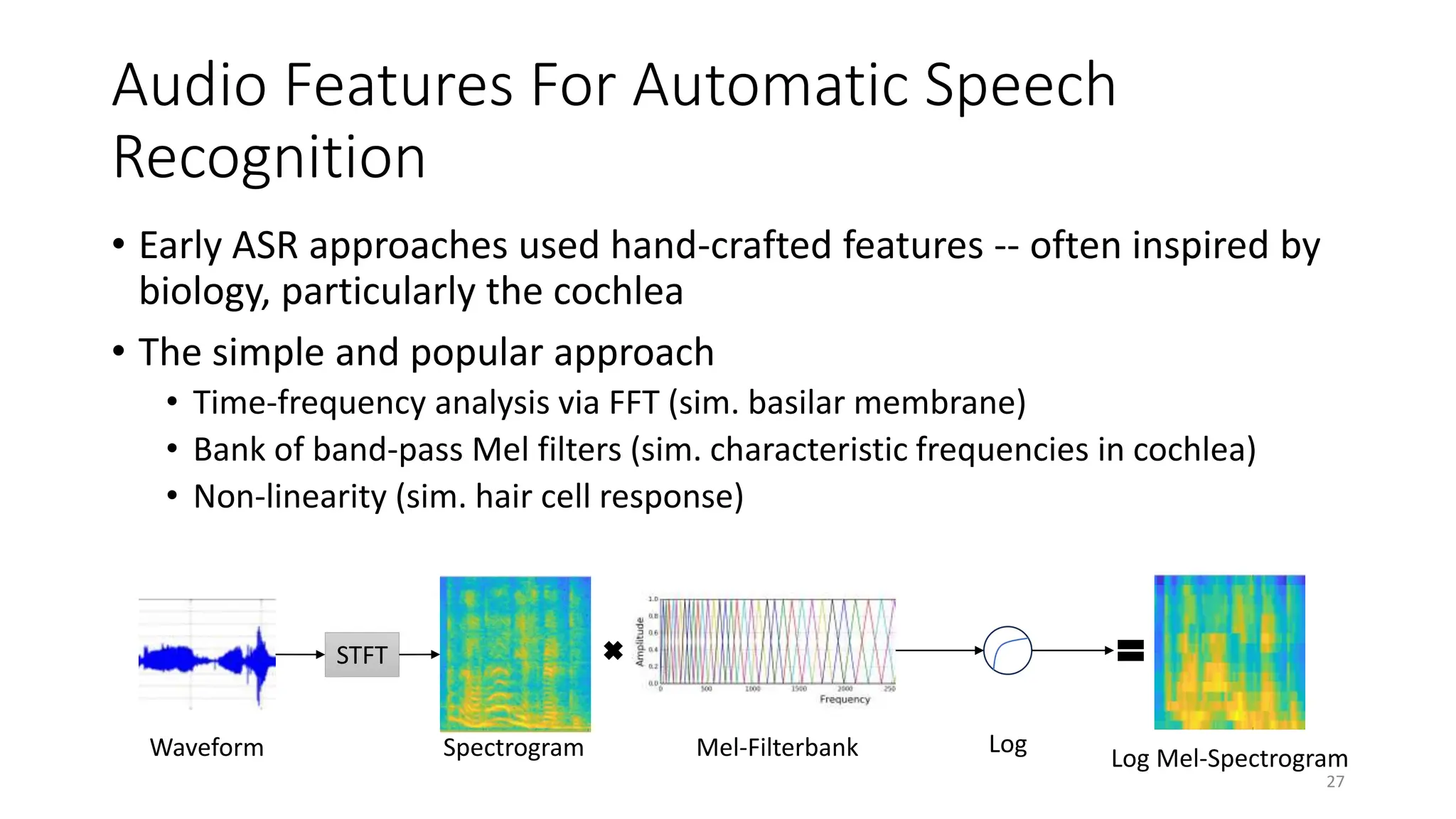

![Features Evaluated So Far
Feature Salient Feature
Log Spectrogram Time-frequency representation + non-linearity
Log Mel Spectrogram Triangular RFs with CFs on the Mel Scale
Cochleagram
[Feather+23]
Gammatone RFs with CFs on the ERB scale + power-law non-linearity
Gammatone Spectrogram Same as Cochleagram but computed by transforming the STFT
Power Normalized
Coefficients [Kim+10]
Power-normalized Gammatone RFs with CFs on the ERB scale +
temporal masking + noise suppression + power-law non-linearity
Difference of
Gammatones
Lateral suppression by frequencies around the CF
Frequency Masked
Spectrogram
Simulates simultaneous frequency masking
29](https://image.slidesharecdn.com/mit-talk-0412-240429055509-f5cb45c3/75/Biologically-Inspired-Methods-for-Adversarially-Robust-Deep-Learning-28-2048.jpg)
![Lateral Suppression via Difference of
Gammatone Filters
• Lateral Suppression:
• the response at a given CF may be suppressed by the energy at adjacent
frequencies [Stern & Morgan 12]
• Enhances responses to spectral changes and reduces impact of noise
• Proposal: take a difference of Gammatone filterbank
31](https://image.slidesharecdn.com/mit-talk-0412-240429055509-f5cb45c3/75/Biologically-Inspired-Methods-for-Adversarially-Robust-Deep-Learning-29-2048.jpg)
![Difference of Gammatone Filters
• Create 2 Gammatone
frequency response curves
with different widths, and
subtract.
• Normalize by sum of positive
values
𝐺𝑑 𝑘 = 𝐺1 𝑘 − 𝐺2 𝑘
𝐺𝑑 𝑘, 𝑡 =
𝐺𝑑[𝑘, 𝑡]
𝑡 max{𝐺𝑑[𝑘, 𝑡] , 0}
Frequency
Amplitude](https://image.slidesharecdn.com/mit-talk-0412-240429055509-f5cb45c3/75/Biologically-Inspired-Methods-for-Adversarially-Robust-Deep-Learning-30-2048.jpg)

![Applying DoG Filterbank
• Convolve the DoG Filterbank over the STFT
𝑆𝑥
𝐺 = 𝑆𝑥 ∗ 𝐺
• Half-wave Rectify
𝑆𝑥
𝐺
+
𝑘, 𝑡 = max 𝑆𝑥
𝐺 𝑘, 𝑡 , 0
• Non-linear Compression
𝑆𝑥[𝑘, 𝑡] = 𝑆𝑥
𝐺
+
𝑘, 𝑡 0.3
34](https://image.slidesharecdn.com/mit-talk-0412-240429055509-f5cb45c3/75/Biologically-Inspired-Methods-for-Adversarially-Robust-Deep-Learning-32-2048.jpg)



![Frequency Masked Spectrogram
• Estimate the masking threshold
for each (FFT) frequency [Qin+19,
Lin+15]
• Zero-out regions of the
spectrogram where Power-
Spectral Density (PSD) falls below
the threshold
38
Time (window) Time (window)
Frequency
(FFT
bin)
Frequency
(FFT
bin)](https://image.slidesharecdn.com/mit-talk-0412-240429055509-f5cb45c3/75/Biologically-Inspired-Methods-for-Adversarially-Robust-Deep-Learning-36-2048.jpg)
![Estimating the Masking Threshold [Qin+19]
1. Smoothed Normalized PSD
𝑝𝑥 𝑘 = 20log10 𝑠𝑥 𝑘
1
𝑁
𝑝𝑥 𝑘 = 96 − max
𝑘
𝑝𝑥 𝑘 + 𝑝𝑥 𝑘
𝑝𝑥
𝑚
𝑘
= 10log10 10𝑝𝑥 𝑘−1
+ 10𝑝𝑥 𝑘
+ 10𝑝𝑥 𝑘+1
2. Two-sided spreading function
𝑆𝐹 𝑖, 𝑗 =
27Δ𝑏𝑖𝑗 Δ𝑏𝑖𝑗 > 0
𝐺 𝑖 ⋅ Δ𝑏𝑖𝑗 𝑜𝑤
Δ𝑏𝑖𝑗 = 𝑏𝑎𝑟𝑘 𝑓𝑗 − 𝑏𝑎𝑟𝑘 𝑓𝑖
𝐺 𝑖 = −27 + 0.37max{𝑝𝑥 𝑖 − 40,0}
39
masker
maskee](https://image.slidesharecdn.com/mit-talk-0412-240429055509-f5cb45c3/75/Biologically-Inspired-Methods-for-Adversarially-Robust-Deep-Learning-37-2048.jpg)
![Estimating the Masking Threshold (cont.)
3. Pairwise Threshold
𝑇 𝑖, 𝑗 = 𝑝𝑥
𝑚
𝑖 + Δ𝑚 𝑖 + 𝑆𝐹 𝑖, 𝑗
Δ𝑚 𝑖 = −6.025 − 0.275 ⋅ 𝑏𝑎𝑟𝑘(𝑖)
4. Global Threshold
𝜃𝑥 𝑘 = 10log10 10
𝐴𝑇𝐻(𝑖)
10 +
𝑖
10
𝑇[𝑖,𝑘]
10
40
Time
PSD](https://image.slidesharecdn.com/mit-talk-0412-240429055509-f5cb45c3/75/Biologically-Inspired-Methods-for-Adversarially-Robust-Deep-Learning-38-2048.jpg)



![Key Takeaway and Future Work
• Certain biological phenomenon (lateral suppression) improves
robustness to adversarial attack
• While others (temporal masking) do not
• Gammatone FB generally improves robustness
• The gammatone spectrogram has lowest WER on clean data and non-
adversarial perturbations
• Simulate detailed cochlear models (e.g. CARFAC [Lyon 12], Seneff)
• Creating efficient PyTorch implementation taking time.
44](https://image.slidesharecdn.com/mit-talk-0412-240429055509-f5cb45c3/75/Biologically-Inspired-Methods-for-Adversarially-Robust-Deep-Learning-42-2048.jpg)

![Fixed Inter-Neuron Covariability Induces
Adversarial Robustness
46
• Inter-neuron correlations in the brain are
rigid [Hennig+21]
• Inter-neuron correlations in DNNs are
flexible
• Change based on stimulus distribution
Shah, M.A. and Raj, B., Fixed Inter-Neuron Covariability Induces Adversarial Robustness, ICASSP
(2024)](https://image.slidesharecdn.com/mit-talk-0412-240429055509-f5cb45c3/75/Biologically-Inspired-Methods-for-Adversarially-Robust-Deep-Learning-44-2048.jpg)
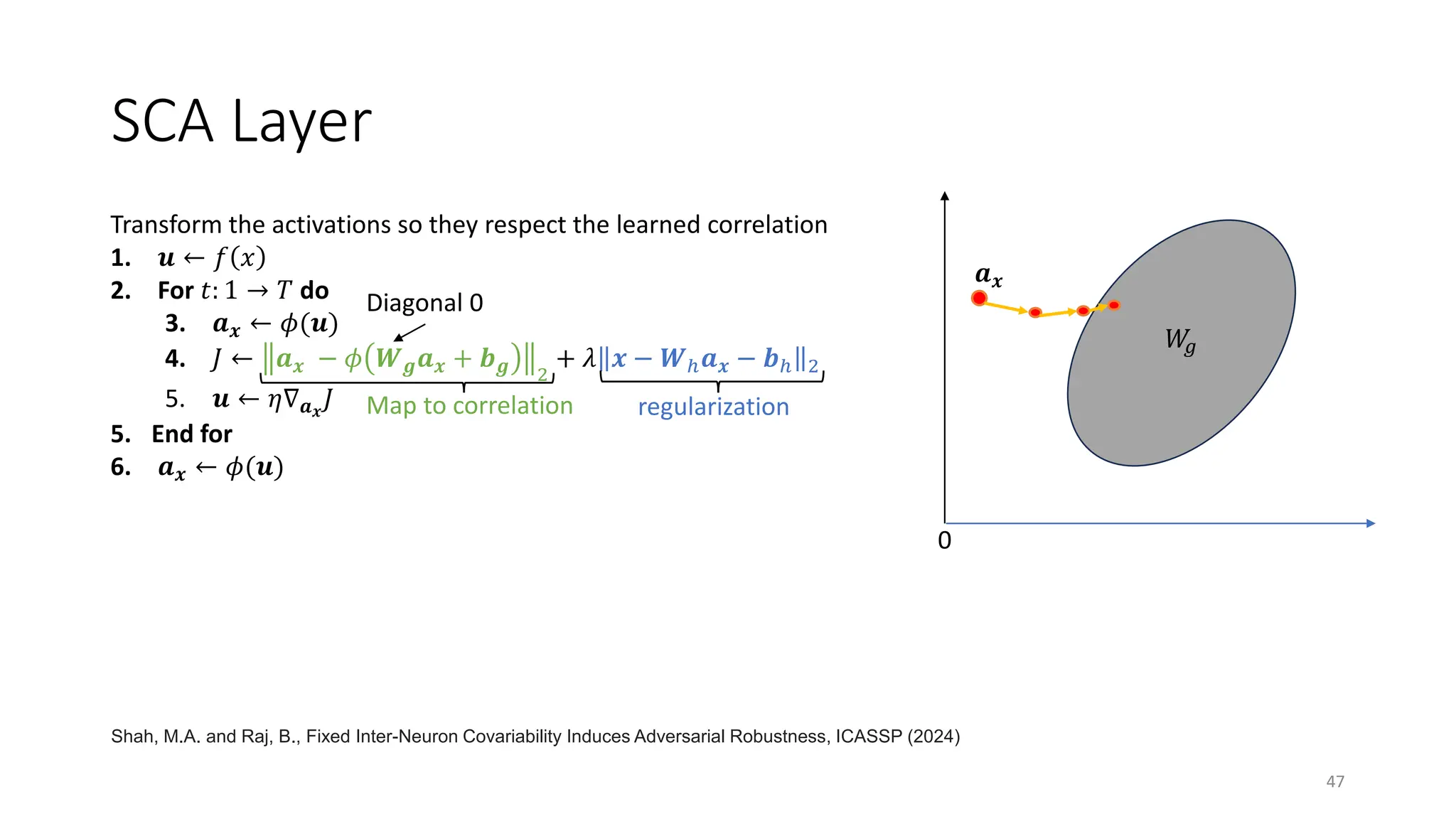



![Recurrent Connections in the Brain
• Recurrent circuits are wide spread in the brain
[Bullier+01, Briggs+20]
• Lateral connections between neurons in the
same region
• Feedback connections from higher cognitive
areas to lower areas
• May fill in missing information due to crowding or
occlusion [Spoerer+17, Boutin+21]
• Not represented in DNNs
51](https://image.slidesharecdn.com/mit-talk-0412-240429055509-f5cb45c3/75/Biologically-Inspired-Methods-for-Adversarially-Robust-Deep-Learning-49-2048.jpg)











